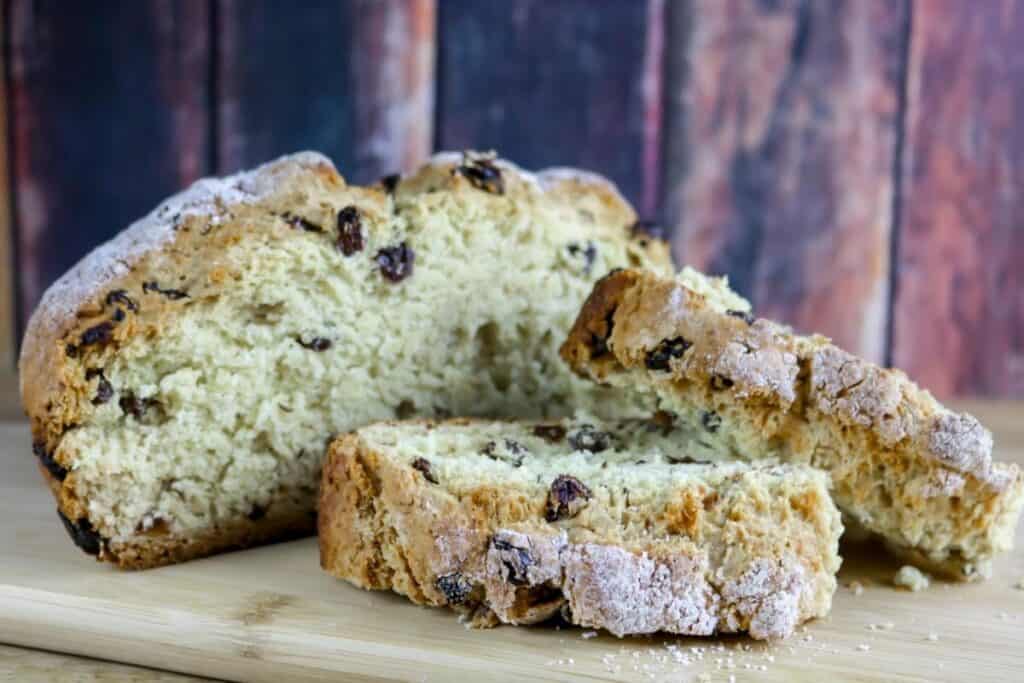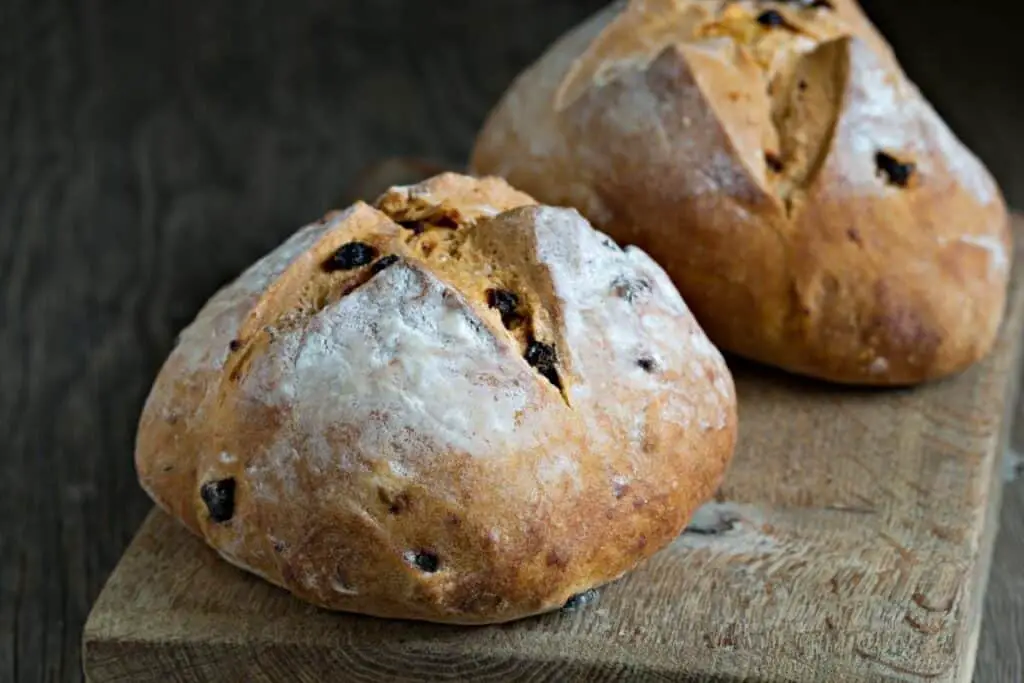Irish soda bread is a popular bread choice that has a rich history. This type of bread continues to be popular today, from its poor beginnings.
The actual name comes from the soda ash (sodium carbonate) that was added to the dough during baking instead of traditional yeast. Today, soda bread is baked in a variety of shapes and sizes.
In this article, we will be going through everything you need to know and including the rich history of soda bread.

What Is Soda Bread?
Soda bread is considered to be a quick bread, which can be seen in a variety of different cuisines. Instead of using yeast, as you would with the majority of bread recipes, you use baking soda/bread soda instead.
The other ingredients that you will always find in a soda bread recipe include flour, salt, and buttermilk. As yeast isn’t used in this kind of recipe, buttermilk is used which reacts with the baking soda.
This reaction is what causes the bread to rise and create tiny air pockets of carbon dioxide that you would normally get when using yeast.
Depending on the recipe, other ingredients can be added to bring more flavor to the soda bread. Some of the optional ingredients that could be used include egg, butter, nuts, or raisins.
What makes this kind of bread so enjoyable is how quick it is. Soda bread can be created and baked really quickly. Therefore, when time is short, and you don’t have lots of time to prove, this is the ideal bread to go for.
A typical soda bread dough can be made within 10 minutes. All you have to do is mix the wet and dry ingredients together until a dough is formed. Then you need to roughly knead the dough and score the top of the dough with a sharp knife.
Finally, all you have to do next is bake the bread until it is golden brown. When you tap the bottom of the bread it should have a hollow sound. That’s when you know it is done. A simple bread that requires little effort and no proofing.
You should try not to overwork soda bread, as it is supposed to look a little rough and shaggy. That is the appeal of this kind of bread. The cross in the middle may make the bread look attractive, but it is also to make sure that the middle of the bread will cook.
History Of Soda Bread
Soda bread has a rich and varied history. It is considered to be one of the oldest forms of bread, it has many origins all over the world. With the most popular being Irish soda bread. For a long time, everyone was using yeast when it came to making bread, however, yeast wasn’t always easy to get a hold of.
In 1791, French scientist, Nicolas Leblanc, created the first form of baking soda, this then led the way for soda bread to be created.
Soda bread became very popular in Europe, this was because it was cheap and easy to make. Thus if money was tight, then soda bread was the perfect solution for anyone who was struggling.
Soda bread is mainly associated with Ireland, yet it also has roots with Native Americans. This is because it is known that Native Americans used pearl ash, which is a natural form of soda that is a result of wood ashes. They would use this pearl ash to help make their bread rise without using yeast.
After that, the Irish created their own version of this recipe, but used baking soda instead, which was first introduced in the 1830s. Eventually, the Irish soda bread made its way to America and adapted it to suit their own needs and tastes.
By 1840, there were around 1,000 soda bread bakeries in Ireland. These bakeries mainly sold soda bread as well as other types of bread such as scones and barmbrack.
Over the next few decades, soda bread fell out of popularity. This was due to the fact that people were becoming more interested in eating bread that tasted better. However, in the 19th century, the demand for soda bread increased again. This is because of the increase in tourism to Ireland.
People wanted something different to eat. Today, most people still buy their soda bread at a local bakery or supermarket. However, many people now also bake it at home.
The original recipe for soda bread was to make a batter out of flour, water, milk, and baking soda. However, this didn’t work very well, so they decided to add an ingredient to the mix that would react with the baking soda.
They found that adding buttermilk worked better than any other liquid. When the baking soda reacted with the buttermilk, it caused the bread to rise.
Today, there are many variations of soda bread available. You can find soda bread at almost any bakery shop today. Soda bread has been around for centuries and is popular all across Europe.
It is seen as a classic Irish staple that can be seen used in many households. It is ideal alongside a hearty stew, or with jam spread on top for an afternoon snack. In the days before St. Patrick’s Day, hundreds of soda bread are baked, ready for celebrations.
How Was Traditional Irish Soda Bread Made?
When soda bread was really popular in Ireland, there was widespread famine. Therefore, bread had to be made out of the cheapest and basic ingredients that people could get their hands on.
These were salt, baking soda, soft wheat flour, and sour milk. Today we would use buttermilk, but back then sour milk was all that they had or could afford.
Soft wheat contains less gluten than traditional hard wheat that works better in yeasted bread recipes. Alongside this, soft wheat doesn’t react well with yeast and doesn’t rise well, thus it is more ideal for baking soda and buttermilk.
Traditionally, many families in Ireland wouldn’t have had access to an oven, this was due to them living in isolated farms. As a result, they had to bake their bread differently. They would cook their soda bread on either a griddle on an open fire or in a three-legged iron pot.
Cooking the soda bread this way is what gives this product its dense texture and hard crust. Whilst also giving this bread a slightly sour taste. The dense texture of the bread was due to the reaction between the baking soda and sour milk.
Appearance

As mentioned above, this bread is supposed to look rough. However, originally, how this bread looked depended on where in Ireland you were. For the Northern regions of Ireland, they would divide their soda bread into four portions that had a triangular shape. Then each portion was cooked on the flat griddle.
Whilst, if you were in the Southern regions of Ireland, they cooked their soda bread in a more classic way. They keep their soda bread whole and in a circular shape. They then use a sharp knife to cut across on the top of the bread.
We know that this cross was put there for superstitious reasons. This is because families believed that the cross would protect the household by warding off any evil spirits.
This is the style of soda bread we are more used to seeing, especially in bakeries. However, all over the world, everyone has their own twist on what soda bread should look like. Some prefer a rounder loaf, some like theirs more square. Everyone has their own preference. Yet what everyone enjoys is how quick this bread is to make and bake.
Modern Soda Bread
Today, soda bread is still enjoyed and in Ireland, you can’t go far without finding some baking or buying soda bread. In Ireland, soda bread is seen as a national culinary treasure and is a part of their history and roots.
However, while the majority of ingredients have stayed the same, some people now like to add their own twists to this classic bread.
In America, it is common to see honey, caraway seeds, raisins, and currants being added to the classic soda bread recipe. While some modern Irish soda bread recipes may include orange zest, nuts, and sometimes even Guinness.
More flavors are being added to the quite plain recipe to make it interesting. Therefore, you can now find quite a broad range of soda bread, and if you make your own you can add whatever you like.
The flavors of soda bread may have slowly changed over the years and become more complex, but the basic bread continues to be loved. Also, the way we eat soda bread still hasn’t changed either. It is best sliced with a thick layer of cold unsalted butter and served with a hearty beef stew.
Final Thoughts
Soda bread is a very versatile food. It can be eaten at breakfast, lunch, or dinner. It started off as an alternative to yeasted bread, which is a lot easier to make with much less effort. Alongside this, they used cheaper ingredients that are more affordable to come by.
Today, the love of Irish soda bread is still there, and new variations of this bread are constantly being created.
It can be used as a side dish, or even as a dessert. It is particularly enjoyed with soups, stews, and sauces. You can serve it hot or cold, depending on your personal preference. So next time you visit your local bakery, try out one of these delicious bread.
